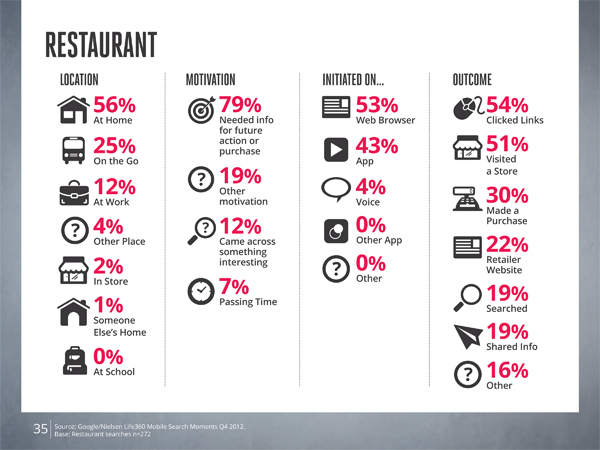Before I begin, let’s make one thing clear about smart phones and restaurants: Ever since iPhones started proliferating, they have made your dinner companions a whole lot ruder, as they increasingly had their stares affixed to their touch screens and listened to less and less of the conversation. That part is no fun.
However, smart phones have obviously been a huge net positive for restaurants in almost every other way, from branded apps to the unleashing of food porn on Instagram to essential customer reporting tasks like mobile surveys. And in two recent research reports, we can see just how much mobile search has benefited the industry.
In a survey of nearly 1,500 smart-phone users, 81 percent of consumers reported that they searched for a restaurant in the past six months using a mobile app, while 92 percent did so through a mobile Web browser, according to SinglePlatform and research firm Chadwick Martin Bailey. That made restaurants the most-searched category in the study.
The search traffic also led to a high incidence of restaurant visits, the study found. Three-fourths of the consumers who searched for a restaurant with a mobile phone chose a restaurant based on search results.
It’s also important to note that smart-phone users often are comparison-shopping restaurants, as 84 percent of those consumers surveyed said they are likely to look on their phones at more than one restaurant before deciding where to eat. A full 80 percent of people said it is important to see a menu before they dine at a restaurant, and 70 percent of respondents went further to say that restaurant menus should be readable on a mobile screen.
If they’re not, restaurants could lose out on a sale: 62 percent of consumers said they are less likely to choose a restaurant if they can’t read the menu on a mobile device.
Bare-minimum lesson: Even before your restaurant gets involved with mobile apps, which is getting cheaper and more turnkey all the time, it should at least have its website mobile-optimized for people pulling the page up on a smart-phone browser.
Years ago, when looking at the big pizza chains’ moves into mobile commerce and smart-phone apps, I had a couple CMOs tell me they were going to mobile-optimized Web route while they waited for development costs of apps to come down. Even now that those costs aren’t nearly as high as they once were, I would say the mobile-optimized website is still the important first step before executing the rest of an M-commerce plan.
A separate study from Google and Nielsen, two analytics powerhouses if ever there were any, had even more interesting information on mobile searches for restaurants.
In the firms’ “Mobile Search Moments: Understanding how mobile drives conversions” study, Google and Nielsen found that mobile searches are strongly tied to specific situations, such as queries about products and pricing while shopping, which are twice as likely to happen while the phone users are standing in a store.
Regardless of where smart-phone users search — 77 percent of searches occur at home or work, with another 17 percent occurring on-the-go — follow-up conversions like a store visit, phone call or online purchase, happen quickly, with 55 percent of those actions taking place within an hour of the search.
The vast majority of mobile searches occur in the afternoon and evening, Google and Nielsen found, which is right in the wheelhouse of any restaurant marketing itself for lunch and dinner.
What I found most interesting is that restaurants were the category most searched on the go. Consumers looking for restaurant information on smart phones were 50 percent more likely than the average user looking up anything to make that search while on the go, far more than the arts and entertainment, food, shopping and tech categories. The travel category came close, with an index of 46 percent more likely than average to be searched for on the go.
 Restaurant searches indexed below average for at-home searches and at-school searches, though they indexed a little higher than normal for in-store and for at work.
Restaurant searches indexed below average for at-home searches and at-school searches, though they indexed a little higher than normal for in-store and for at work.
What I surmise from that information is that location is everything in mobile commerce for restaurants. Make sure your locations are visible and have the correct coordinates on location-based apps like Foursquare or in map sites like Google Maps. Also, since people are open to finding out about restaurants while between destinations, restaurants could and should explore programs for geofenced offers and alerts.
The Google/Nielsen report also broke down statistics just for restaurants searches, and one that stood out to me is that 53 percent of searches were initiated on a Web browser, compared with 43 percent on an app and 4 percent via voice.
 Of all the outcomes survey respondents could have had after searching for a restaurant, 54 percent of them clicked links on results, while 51 percent visited a store and 30 percent made a purchase. Another 22 percent visited the brand’s website, while 19 percent searched again and 19 percent shared information with friends via text or social media.
Of all the outcomes survey respondents could have had after searching for a restaurant, 54 percent of them clicked links on results, while 51 percent visited a store and 30 percent made a purchase. Another 22 percent visited the brand’s website, while 19 percent searched again and 19 percent shared information with friends via text or social media.
It’s a lot to think about — and a lot to read on your mobile screen if that’s how you like to access NRN. Now put the phone down. Your dinner date is annoyed.

